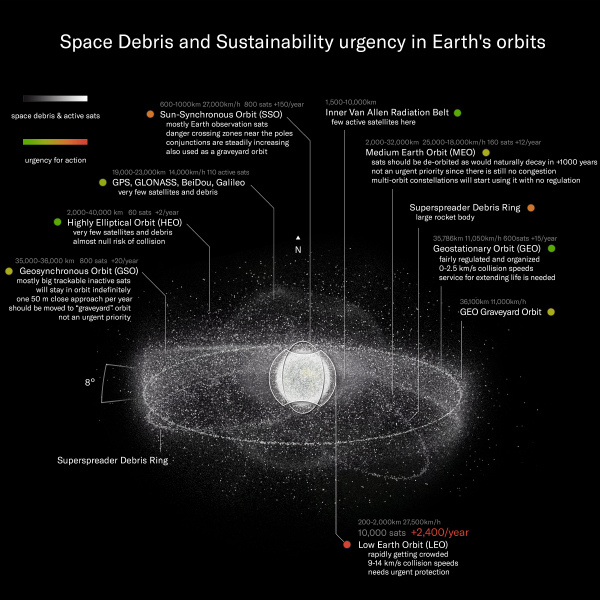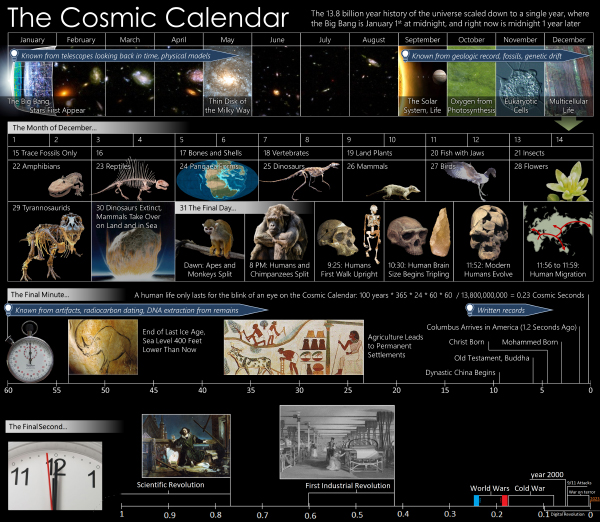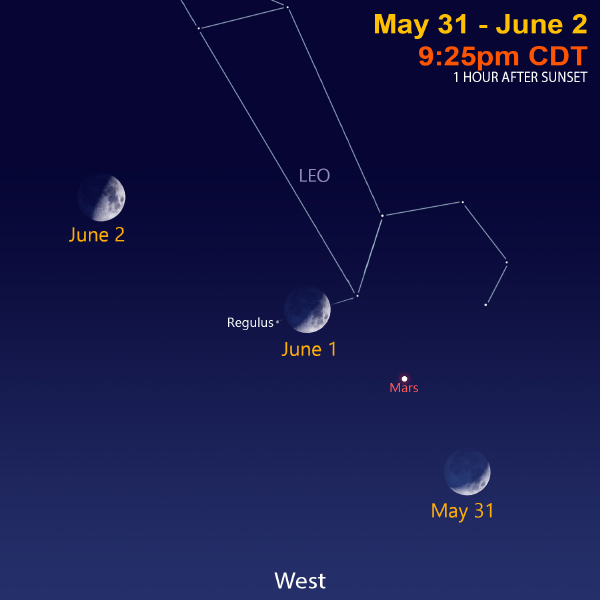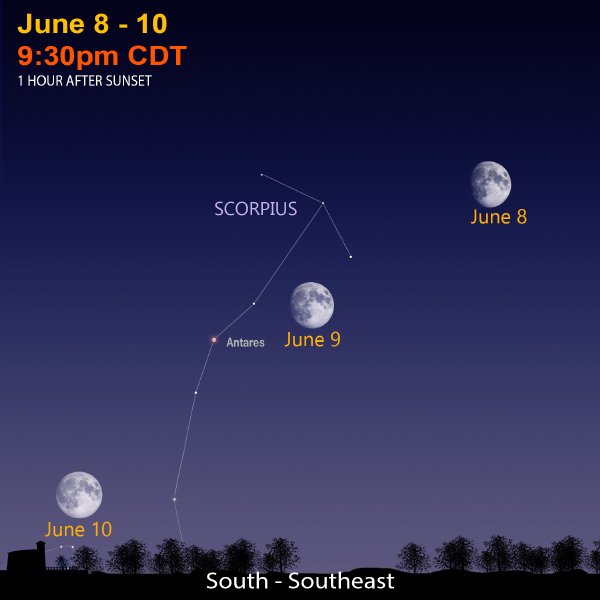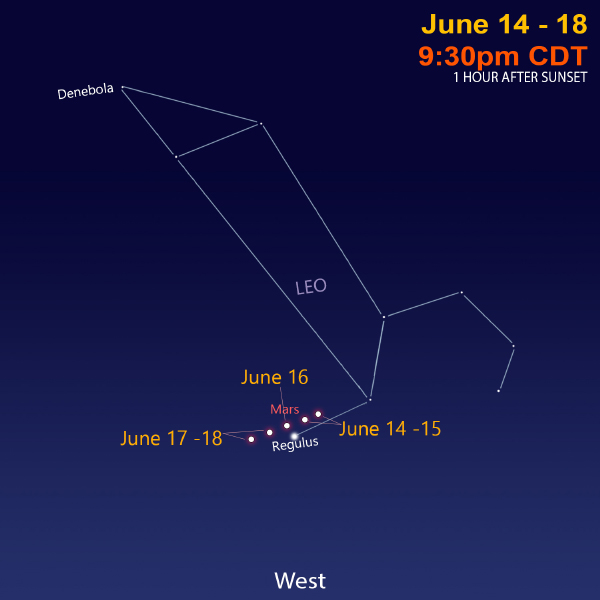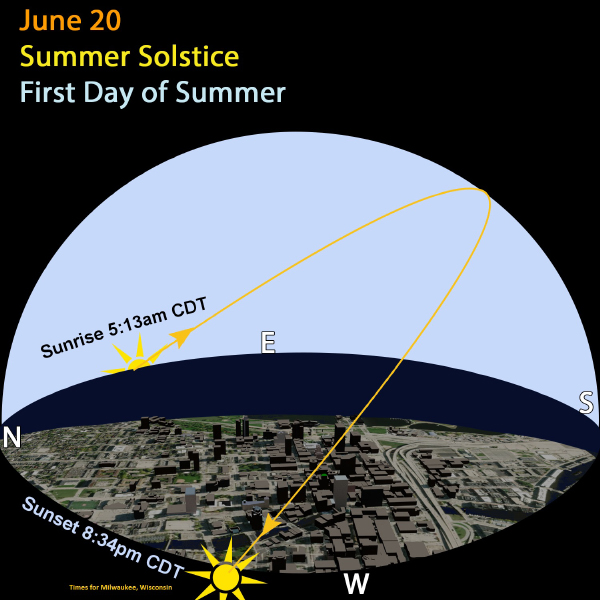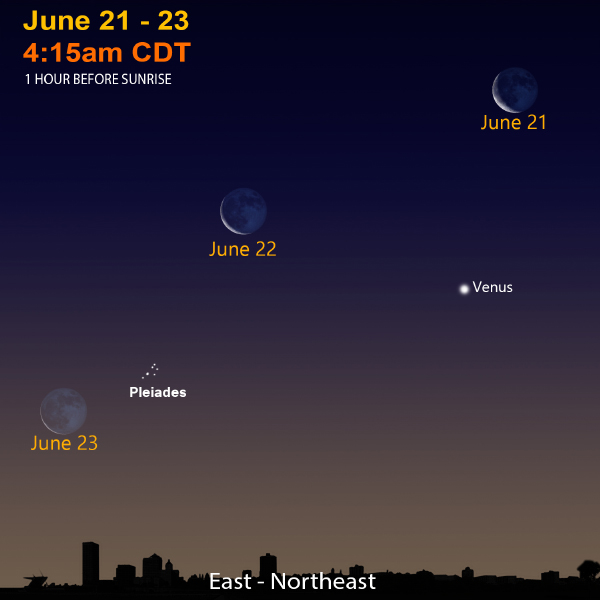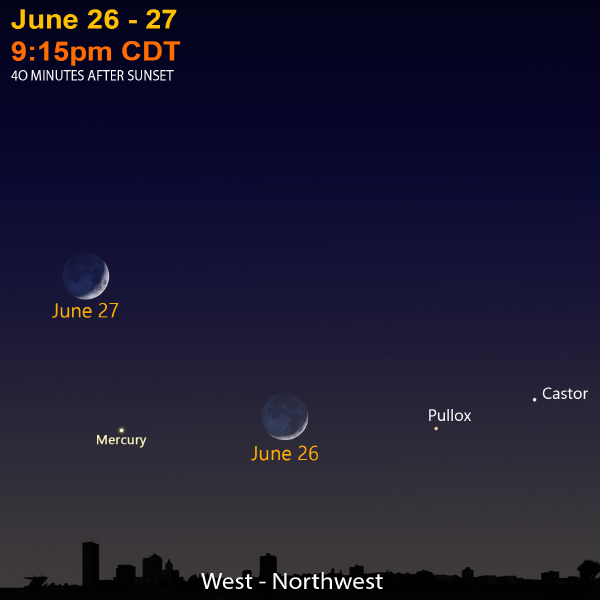Cosmic Curiosities
"It is a school, a theatre, a cinema in one; a schoolroom under the vault of heaven, a drama with celestial bodies as actors.”
- Professor Strömgren, Copenhagen Observatory Director, 1928
What is a Planetarium?
I work in a planetarium, so I know what they are, right? They are places to project stars and planets and teach about how they work and move. Sure, this is true, but planetariums can be more complicated and nuanced than that simple description.
PLANETARIUM STORIES
A few people have asked me throughout the years, “What do you guys grow at the 'plant-arium'?” That was a tough question to answer without myself laughing.
Once, in a fundraising meeting in Minneapolis, a leader questioned us with this, “Why do you want money to build a new planetarium downtown, with all the bright city lights?” I quickly realized this person thought we wanted to build an observatory with telescopes that look at the real sky. Again, I wanted to laugh, but we should have clarified what a planetarium does exactly.
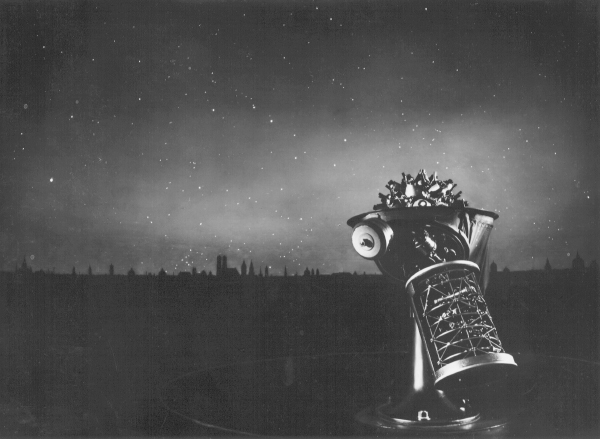
Credit: Zeiss Company
The modern planetarium—where visitors can see simulated stars and planets accurately projected on a dome—started 100 years ago on May 7, 1925, in Munich, Germany at the Deutsches Museum. Planetariums expanded to America in 1930 with the opening of the Adler Planetarium in Chicago. The first one in Milwaukee was the Manfred Olson Planetarium at the University of Wisconsin-Milwaukee, opening in 1966. Our Daniel M. Soref Planetarium came along in 2006.
Below is a short selection of possible planetariums—places where stars and planets are shown. Their methods reveal a vast array of starry purposes.
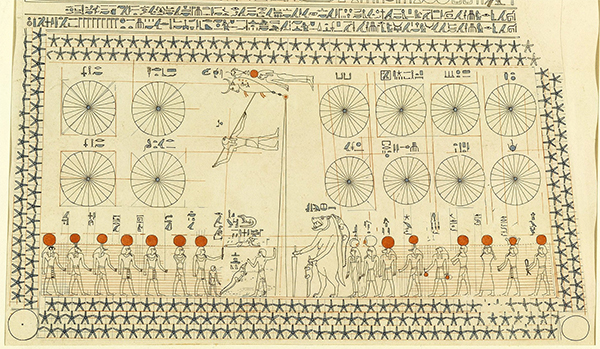
Drawing of Tomb Ceiling; credit: NebMaatRa
Planetarium Timeline
- 1473 BCE - Egyptian tomb of Senenmut features the earliest known depiction of the sky
- 370 BCE - Atlas Globe showing Celestial Sphere—Greece
- 250 BCE - Archimedes cast-metal globe showing the motions of the planets—Greece
- 50 BCE - Zodiac Ceiling, Hathor temple at Dendera—Egypt
- 150 CE - Ptolemy's designs Celestial—Egypt
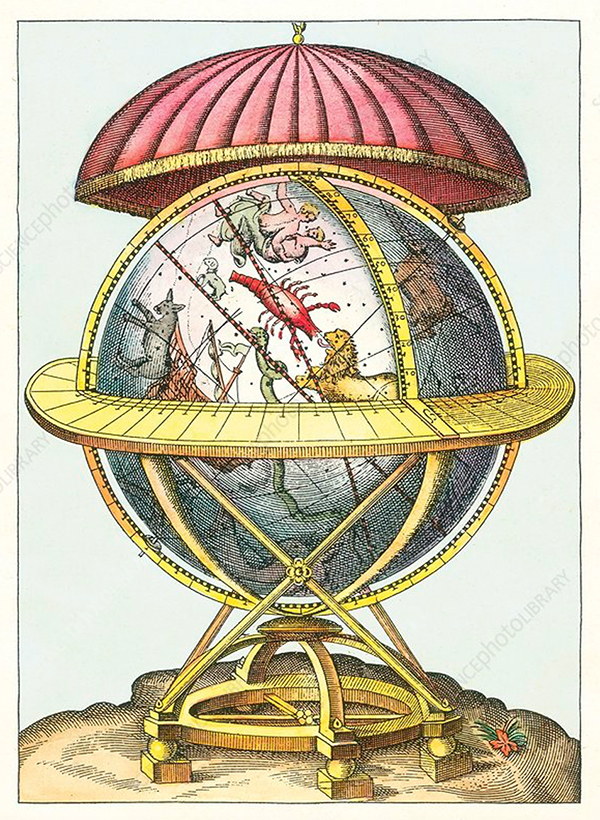
Drawing of Tycho Brahe's Celestial Globe; credit: DETLEV VAN RAVENSWAAY / SCIENCE PHOTO LIBRARY
- 1584 - Celestial Globe by Tycho Brahe—Denmark
- 1654 - Globe of Gottorf, people seated on inside; stars were holes in sur—St. Petersburg
- 18th century - Navajo Star Ceilings painted by hand—Modern-day Arizona
- 1781 - Eise Eisinga Orrey or Planetarium—Netherlands
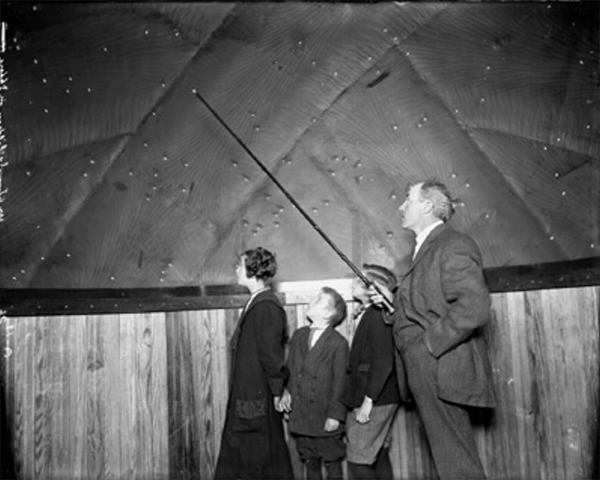
Wallace W. Atwood inside his Celestial Sphere; credit: Adler Planetarium Archives
- 1913 - Atwood Globe shows stars and planets on inside—Chicago
- 1925 - First modern planetarium opens to the public—Germany
- 1930 - First American planetarium opens—Adler in Chicago
- 1947 - Armand Spitz designs a less expensive projector; within 10 years, the number of US planetariums rises from five to 200—United States
- 1983 - Evans & Sutherland design first digital/computer planetarium—Utah
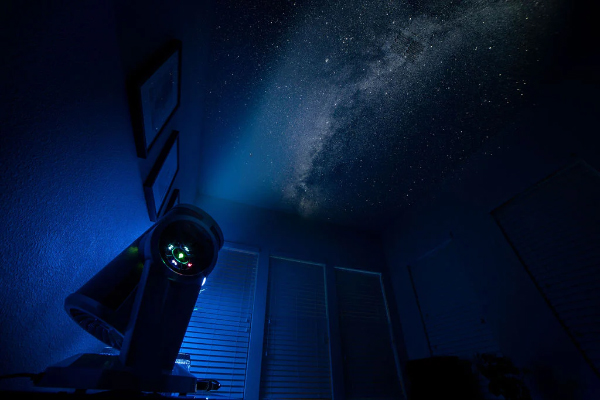
Credit: Dark Sky Company
Today, more than 150 million people, every year, visit a planetarium! There are 4,000 starry domes worldwide. And you can even get a planetarium at home and learn about the heavens. Many companies make small projectors that can replicate the night sky on your ceiling. How good are those planetariums exactly? Well, that's another story.
Space Junk
When you think of space, what comes to mind? Countless stars and planets? Picturesque nebulae and galaxies? Or maybe the incredible vast distances? Have you ever thought of space junk?
Humans have rocketed plenty of spaceships. Much of this has turned into space junk. Since Sputnik 1 in 1957, we have launched over 8,000 satellites into Earth orbit. Of these, about 3,600 remain in orbit, with roughly 1,000 still functioning.
So, what can we do at the end of a satellite's life?
Diagram of orbits that satellites and debris can inhabit; credit: Pablo Carlos Budassi
There are multiple ways we handle decommissioned space junk. Those orbiting closer to Earth are lowered to an altitude where they burn up and disintegrate due to the intense friction with Earth's atmosphere. Such events appear as slow-moving fireballs, especially with larger break-ups. Perhaps you were fortunate to see such a sight this past January with the disintegration of Starlink Satellite 5693!
Starlink 5693 Burns up January 2025; credit: Fox Weather Sheboygan
If any space junk's reentry has any chance of injury or property damage, satellites are required to undergo a "controlled deorbit." The debris is targeted to land in an uninhabited patch of the southern Pacific Ocean called the "Spacecraft Cemetery." Such processes may not be possible, however, for satellites orbiting at higher altitudes, so a third, final option is to launch them farther out, clearing busier operational spaces to spend the rest of their existence in a remote "graveyard orbit."
A WISCONSIN STORY
A famous piece of space junk landed in Manitowoc, Wisconsin. Around 5:30 a.m. CST on September 5, 1962, two police officers were surprised to find a strange metal object imbedded in street asphalt and too hot to handle. The 20-pound and 8-inch-by-3-inch oddity hit near the middle of North 8th Street, near the intersection of Park Street.
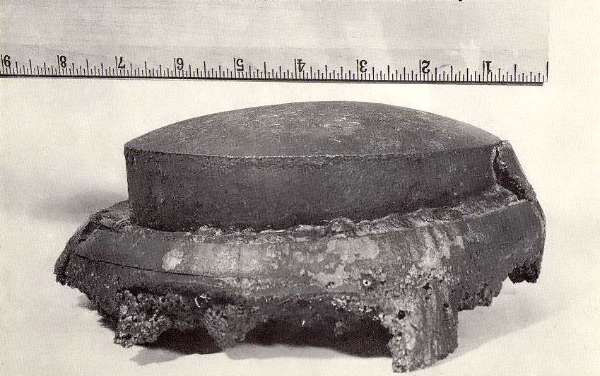
The space junk turned out to be Sputnik 4, the first test flight of the Soviet Vostok program for human spaceflight. It was launched from Kazakhstan on May 15, 1960. Many people saw many pieces of Sputnik 4 brighter than the planet Venus. It took several days for investigators to realize it was part of a Soviet spacecraft.
A RECENT REENTRY
Another Soviet spacecraft crashed back to Earth just last month. Though this time, Manitowoc was able to breathe a sigh of relief. The Soviet Kosmos 482 probe was launched in late March 1972 to land on and study scorching Venus. A rocket boost to propel it to Venus failed, and Kosmos 482 was marooned in Earth orbit for more than 50 years!
Earth orbit is not completely frictionless. There are tiny amounts of molecules that will decay a satellite's orbit. So, Kosmos 482 slowly drifted closer to Earth. Since the craft was designed to survive the boiling temperatures of Venus' atmosphere and surface, curious people wondered if parts of this uncontrollable spaceship would survive reentry and potentially harm Earth. Luckily, it fell harmlessly into the Indian Ocean west of Jakarta on the morning of May 10.
Kosmos 482 Reentry Animation; credit: Fraunhofer FHR
We learn at a young age that 71% of the Earth's surface is covered in water. Not well known is that urban areas on Earth account for only 3% of our surface—and we humans do not occupy each square foot of our urban cities. This means that falling space junk, or even a meteorite, impacting us directly is minimal. We do know of one person hit by any object from space. A grapefruit-sized meteorite hit Ann Hodges in 1954 in Alabama. She was mildly hurt in her leg as the meteorite lost much of its speed, tearing through the atmosphere and then through her house.
Credit: skyatnightmagazine.com
When Skylab fell in July 1979, despite the media fervor and bullseyes being printed onto T-shirts and funny hats, there were no documented injuries or deaths. So, rest easy; there's no need to wear a helmet or hard hat on your next walk. If you see a fireball in the sky, check in with your local news (or planetarium) to see what caused it!
Fate of the Universe
Credit: Wikipedia Efbrazil
The history of the universe is wondrously depicted in the Cosmic Calendar. Go ahead and explore this fascinating timeline!
Like life itself, the universe is always evolving. It's been expanding and changing since its birth 13.8 billion years ago. But what is the fate of our universe (in the extremely long-term sense), billions and billions of years from now? Will it stay the same? Will it die? Before we explore this cosmic destiny, we need to briefly cover two big mysteries: dark energy and dark matter.
Credit: NASA
Based on our measurements of dark matter and dark energy, we know that regular matter only makes up about 5% of the total matter-energy in the universe. For dark matter and dark energy, the exact breakdown varies, but their densities are usually put at around 25% and 70%, respectively.
Almost 30 years ago, we discovered our expanding universe is accelerating! This force is an unknown entity called dark energy. Dark energy is amazing because it outperforms gravity, which, with all the countless galaxies and stars, wants to pull the universe closer together. Then, there is dark matter. Dark matter is a bit like dark energy because it is also mysterious; we can see its effects through astronomical observations, but we have no idea what it is. We cannot see it, but we know its location and can map its density.
FATE #1: BIG RIP
One outcome for the fate of the universe is the Big Rip. This is what will happen if the relative presence of dark energy starts to overpower that of dark matter and regular matter. In this case, the universe will continue to accelerate to the point that it will be expanding so fast it will cause everything to be ripped apart into elementary particles. The repulsive force exerted by dark energy will be so strong that no structure can be held together. First, the galaxies will dissipate, and then, gradually, more rigid structures will be torn apart, as well.
FATE #2: BIG FREEZE
Next, we have the Big Freeze or the Big Chill. This is what will happen if the relative proportions of everything stay the same. In this case, the universe continues to expand. Eventually, stars run out of fuel to burn and cease to exist. Black holes will dominate the universe for some time, but with nothing to feed them, they will slowly evaporate into Hawking radiation. At some point, the universe will reach a minimum temperature and a point of maximum entropy. Everything will have spread out and occupied all available states as demanded by the second law of thermodynamics—or the heat death of the universe.
FATE #3: BIG CRUNCH
There's the Big Crunch. This is when the presence of regular and dark matter overpowers dark energy and pulls everything back together. The universe will collapse back upon itself into one singularity.
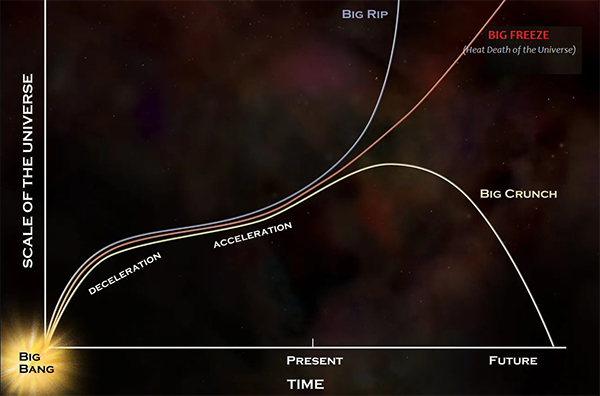
Credit: NASA/CXC/M. Weiss
FATE #4: BIG BOUNCE
Since its discovery in 1998, dark energy's power was thought to be constant regardless of the size of the universe. However, recent observations by the DES (Dark Energy Survey) and DESI (Dark Energy Spectroscopic Instrument) projects have found evidence that dark energy may be weakening throughout time. This shatters our understanding of the nature of dark energy. It may mean the fate of the universe is a collapse, like the Big Crunch. It also leads to the fascinating possibility of the Big Bounce. If the universe collapses back together, it may “bounce back” and expand again, creating a new Big Bang and a completely refreshed universe. Maybe this would happen over and over again!
Credit: davidope/Quanta Magazine
Still, if dark energy can change in strength, it can also start getting stronger again later in time, even if it is lessening now, so who knows what can happen.
As always, these potential futures are all just theories that cosmologists continue to explore. While current evidence may point one way or another, this discovery that dark energy can change makes everything much more unpredictable. How exciting!
Space in Sixty Seconds
Observe the Strawberry Moon and see how the summer solstice is at the top of a bowling pin!
Sky Sights
You might catch the bright planet Jupiter very early in June after sunset, but it will be lost in the sunset's glare by June 15. On June 24, Jupiter will be at Superior conjunction, when Jupiter lines up behind the sun as the faster Earth speeds by.
From May 31 to June 2, spot the Moon orbit past the more distant Mars and move through the constellation of Leo the Lion.
The full moon in June is called the Strawberry Moon. It will take a very shallow path across the night sky and shine very close to the bright star Antares in Scorpius on June 9.
Watch fast Mars swing past the bright star Regulus in Leo from June 14 to 18.
Summer arrives astronomically—aka the Summer Solstice—on Friday, June 20, at 9:41 p.m. CDT. We have more than 15 hours of daylight, and the sun is 70 degrees high in the sky at midday.
For very early risers, glimpse a waning crescent Moon near crazy bright Venus on pre-dawn mornings of June 21 through 23.
Mercury makes a great showing in the early evening sky toward the end of June. Use the waxing crescent Moon to spot the smallest planet on June 26 and 27.
Saturn rises after 2 a.m. CDT on June 1 and by 12:30 a.m. at June's close. Look for the ring jewel in the southeast morning sky in the constellation Pisces the Fish.
June Star Map
Sign Up
Receive this newsletter via email!
Subscribe
See the Universe through a telescope
Join one of the Milwaukee-area astronomy clubs and spot craters on the Moon, the rings of Saturn, the moons of Jupiter, and much more.
Follow Bob on social media
Twitter: @MPMPlanetarium
Facebook: Daniel M. Soref Planetarium


